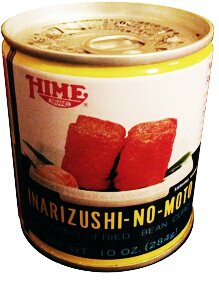What is Inari?
Inari is a wonderful thing in the world of sushi – crispy, delicious, soft, and utterly unique. We adore them whenever we’re cooking or even going out for sushi. To learn a little more about the wonderful food, we’ve broken down some key pieces of knowledge for you here.
History
Inari sushi is a wonderful dish that has been around for a long, long time. Essentially, it comprises a tofu pocket that has been cooked in dashi broth to absorb the flavor, before being squeezed (to remove excess liquid) and stuff with sushi rice. The pockets are then fried so that the outer layer is wonderfully crispy.
The dish gets the name ‘Inari’ from a Japanese god of the same name. This deity is said to guard crops, as well as being a god of sake and fertility. A similar figure can be seen in a number of mythologies, such as Bacchus in Roman mythology or Dionysus in Greek mythology.
The god is said to resemble a fox, and so at fox-shaped statues within Inari shrines, these deep-fried tofu pockets are presented as offerings. This goes a little further, too. Foxes in the wild are said to be messengers of Inari, so the tofu-and-rice snack is sometimes given to them, too.
The dish has been enjoyed for over a hundred and seventy years, and in the 1980s, between 300,000 and 450,000 pouches were made every single day! Of all the soybeans that were used for tofu production in the world, a third was used for Inari, specifically.
While the love for these little pockets has shrunk a little, people do still adore them. Nowadays, it’s quite easy to track them down in the refrigerated sections of Asian supermarkets, but they can be found online quite easily too.
Culinary Use Today
Inari is definitely used and made all over the world today, but there’s an interesting little competition happening in Japan between Tokyo and Osaka. Because tofu and rice are such versatile ingredients, there have been a number of different recipes and methods of manufacture which have resulted in slight differences in the final product.
Tokyo-style Inari sushi is generally shaped a little like a straw bag (which is to say rectangular, with a bulge for the filling). The sushi rice within the Inari sushi is completely surrounded by the tofu, meaning that it maintains its heat and flavor a little more.
This has a little historical footing in that when the dish was originally created in this form, the rice was added to thank Inari for such a wonderful and prosperous harvest. Therefore, the sack-shaped Inari could have been representative of real-life sacks full of rice, leading to the miniature copycat.
Osaka-style Inari sushi is a different shape completely: triangular, with the rice exposed at the bottom of the shape. Sometimes, the inari sushi is inverted, so that the opening sits at the top of the triangle, exposing the rice from a birds-eye point of view. This is sometimes referred to as bag-shaped, as though a sack of rice has been opened, and is a little misshapen, thanks to the redistribution of the rice.
The main difference in terms of ingredients, though, is that Osaka-style Inari sushi is mixed with other ingredients to bring a number of additional flavors and textures to the mix. There are no hard and fast rules for this, and sushi chefs will often simply add their favorite ingredients.
The historical foothold for this triangular shape is that the triangular shape is slightly reminiscent of a fox’s pointy ears. As we mentioned before, the fox is considered the messenger of Inari (the god), and the god’s physical form is said to be that of a fox.
What It Brings To Sushi Making
Well, this is a tough question to answer, but it’s one that we enjoy thinking about.
The thing that we like about inari sushi is that it brings a lot of different flavors to one mouthful. A lot of sushi dishes are seemingly about the combination of one or two textures and similar flavors. Inari sushi combines the softness of tofu with the crispy outer shell, as well as the rich and fluffy texture of the internal rice. This combination is unique and fascinating, which is one of the wonderful reasons that Inari is still adored today.
We hope that you loved this brief look at Inari sushi – it’s one of our absolute favorite foods in the world of sushi, and if you haven’t tried it, make sure to pick some up! Alternatively: make some yourself!
Where can I get me some Inari?
As in most sushi ingredients, you can find Inari in your local Asian food store or Japanese market. This product is also available on our online store and through the link below.



What is inari? Is it pland or dead animal?
I buy sushi rolls at our supermarket. This week there are two inari sushi included. Can they be served cold (room temp) along with the other sushi, or should they be heated? Thanks
Inari should be served in room temperture like most types of sushi. Depending on the filling you can warm it up if you like, but you do not have to.